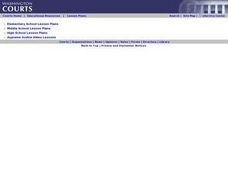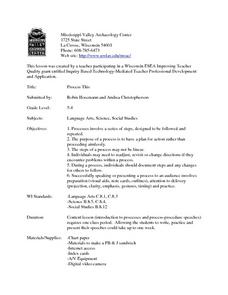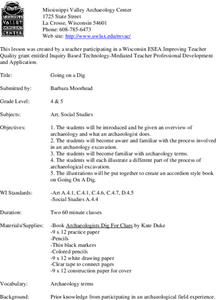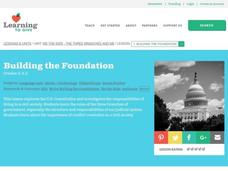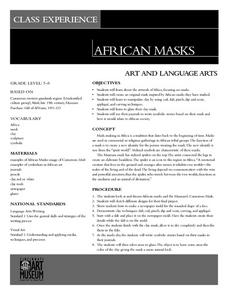US Institute of Peace
Responding to Conflict: Mediation
What happens when two parties can't come to agreement? Scholars explore the role of a mediator through part 10 of a 15-part series of peacebuilding lessons. Through individual work and role play, pupils brainstorm solutions until they...
US Institute of Peace
Advanced Mediation Practice
What will become of the giraffes of Amali? Pupils participate in a large scale role-playing activity to study the art of conflict mediation. The lesson engages participants in the struggle between two countries and the animals caught...
US Institute of Peace
Mediating Conflict
Two's a negotiation, but three's a mediation! Demonstrate the differences between the two processes through a role-playing lesson plan. The activity familiarizes pupils with the role of a mediator and examines the types of situations...
Curated OER
Conflict Mediation - Part 2: Practice
Fourth graders work in small groups and try the mediation process, taking turns as mediators and disputants. They discuss and review the handouts over the concepts of mediation. Students volunteer to participate in the class role-play.
Curated OER
"A Primer On Peer Mediation"
High schoolers examine the process of peer mediation. They watch and discuss a video, identify the guidelines of mediation from the video, identify conflicts they have been involved in, and role-play a dispute using the mediation process.
Curated OER
Conflict Resolution and Peer Mediation
Students investigate a problem and look at the associated positive and negative choices and consequences. They work together to make a group decisions and role play in peer mediation situations.
University of New Mexico
Lesson Plans and WebQuests
Students review an overview of mediation techniques and listening skills. They practice good listening skills which are needed for the mediation process and discuss icebreakers in pairs to better utilize good listening skills.
Curated OER
Judges in the Classroom: Mediation
Students list the steps in the mediation process. They role play in various mediation situations.
Theodore Roosevelt Association
Defining America's Role in the World
As the first American president to win the Nobel Peace Prize, and only one of four presidents to do so in United States history, Theodore Roosevelt's foreign policy achievements and preservation of peace are often overshadowed by his...
Serendip
Homeostasis, Negative Feedback, and Positive Feedback
So many bodily activities depend on homeostasis! Give learners a solid background to understand the basic process of the human body. Scholars first examine negative feedback loops contributing to body temperature regulation and then a...
Curated OER
Down in the Dumps
After an introduction to municipal sludge, middle school ecologists consider the pros and cons of dumping in the Hudson River Canyon. The class is split into two groups: one to debate in favor or dumping and one to debate against the...
Curated OER
Process This
Students chart the steps, including the problem-solving tangent, and discuss the idea of procedures serving to give us a "road map" or guide to help tackle tasks with preparation and forethought.
Curated OER
Going on a Dig
Students study an overview of archaeology and what an archaeologist does. They examine the process involved in an archaeology excavation and illustrate a different part of the process of archaeological excavation.
Curated OER
Filling in the Picture
Young scholars study archaeological sites. They discover some of the problems inherent in choosing sites and what parts are chosen for excavation. They evaluate and explain their choices for study and articulate the process of...
Curated OER
Creating an Enzyme-Substrate Model
Students explore the reaction rates of an enzyme-mediated reaction through experimentation. In small groups, they use everyday objects to demonstrate the effects of environmental variables on enzyme function.
Students graph and...
Curated OER
Building the Foundation
Students understand the purpose of the judicial branch of government. In this judiciary lesson, students participate in exercises to understand how the court system works. Students complete activity sheets to develop understanding of...
Curated OER
Rock the Vote
Learners dramatize the process by which a bill becomes a law. They design a product that explains the function of the Legislative Branch in government and present their work to the class.
Curated OER
An Enzyme- Substrate Model
Students explore reaction rates of an enzyme-mediated reaction. They examine the effects of environmental variables on enzyme function. Students collect, graph, and analyze data relating to the reaction.
Curated OER
The Search for Mid-East Peace
Twelfth graders demonstrate an understanding of the competing forces and their demands in the Israeli-Palestinian peace process by completing a "Force Field Analysis" (developed by John Rossi at Virginia Commonwealth University) and by...
Curated OER
Conflict Resolution Skills Training
Students complete conflict resolution skills training as a part of creating a caring school community. In this conflict resolution lesson, students work with a group of peer student leaders to resolve conflicts. Students visit freshman...
Curated OER
Class Experience: African Masks
Students discover the many diverse artwork produced in Africa while focusing upon masks created in tribal groups. They conduct research using a variety of resources and then use the information as samples for inspiration to create their...
Curated OER
Maps and the Pictures in Our Heads
Geographers of all ages examine different types of maps. They draw maps of their environment, utilizing both three-dimensional and picture maps. They interpret map information, noting how it can sometimes be misleading. Some good...
Curated OER
Pre History through Modern Day Timeline
Students explore the historical sequence of cultures throughout history. They demonstrate the ability to organize events in chronological order and demonstrate how time is measured and annotated.
Curated OER
How Old Is Mike?
Students examine the absolute dating of fossils, they use a list of names and ages to determine the difference between relative age and absolute age. They explore the relative age and absolute age of people and of fossils.









